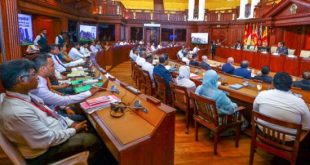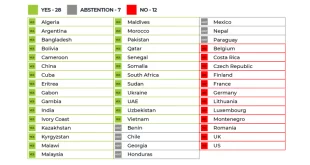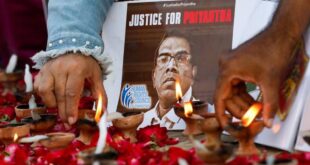Dispute
The dispute over the presence of a Muslim mosque on Buddhist temple land in Dambulla points

Muslims protest in front of the Davatagaha mosque in Colombo
to an underlying tension in Sri Lanka’s multi religious society that is capable of being exploited by extremist forces. It is reassuring that the violence that suddenly manifested itself over the location of the mosque was not permitted to escalate after the ugly incident was publicized by the mass media.
No popular support
There was also no popular support for the actions taken by the religious prelates who led the intemperate attack on the mosque on the grounds that it had trespassed into sacred Buddhist temple land and therefore ought to be removed. The monks themselves probably realized that they had gone too far when they attempted to deny the authenticity of the media images that showed them in the forefront of an angry mob.
Not in favour
It was also evident that at least a section of the government leadership was not in favour of the confrontational posture adopted in Dambulla. A government minister publicly denied that the mosque was situated on temple land. The Prime Minister’s proposed solution of relocating the mosque was his way of solving the problem without permitting it to escalate. But the manner in which this proposal was made without consultation with the Muslim leadership of the area has
Facade of the historic Dambulla cave temple is the focal point of the Buddhist sacred city so declared in 1982 and has ignited protests by monks over other places of worship within this area. The monks want them evicted from the sacred area.
hardened Muslim sentiment against the proposed relocation. The government will be having a serious problem on its hands as the largest political parties representing the Muslim community are an important part of the government coalition. The damage done to the mosque and government inaction has caused a deep sense of hurt and insecurity in the minds of the Muslim community.
Muslim sentiment
Failure of the government
The government cannot avoid the primary responsibility for the incident that led to the desecration of the mosque. The tension had evidently been building up over a period of time and the failure of the government’s early warning systems shows a lacuna that its present strategy of beefing up the military power of the government will not address. There are two divergent positions to be reconciled. One is the position of the Muslim community who affirm that the mosque has been in existence for over sixty years and been a place of worship without disturbance. On the other hand, the temple authorities have taken the position that government laws entitle them to claim the land as part of the traditional temple property. As religion is at the centre of the dispute, goodwill, sensitivity and even-handedness will be necessary attributes of those tasked with engaging in conflict resolution.
Rule of law
It has been pointed out that at least three offences under the Penal Code occurred and were captured on television. These were unlawful assembly, criminal intimidation and criminal trespass. There was a mob, stone throwing and vandalisation of the mosque. In addition there was the violation of the constitutional right to freedom to practice one’s religion. What was especially disturbing was that these incidents took place in the presence of the police who were there in strength, but no action was taken by them to ensure law and order. This can be taken as a sign of some level of governmental complicity in what transpired. In other recent instances of mob action, such as at the protest by fishermen over fuel price hikes and by free trade zone workers over their pension rights the police have acted decisively.
Church burning
In recent times there have been many reports of attacks on religious minorities including church burning and controversy over unethical conversions. The primary source of violent social behavior that has manifested itself in acts of religious violence is the absence of due emphasis to the Rule of Law. Maintaining law and order and civil administration is the prime duty of the government and state machinery. The breakdown of the Rule of Law within the country can lead to a situation where persecuted groups will feel justified in looking elsewhere for justice including the international community. Wherever and whenever there are disputes they need to be settled negotiations or by recourse to the law in competent courts in the country and the use of force cannot be tolerated.
Personal fiefdoms
This is a point that has also been stressed by the Lessons Learnt and Reconciliation Commission appointed by the Government in the aftermath of the country’s three decade long internal war when it said that the Rule of Law and not the rule of men should prevail. It is unacceptable that protests can emerge at anytime and anywhere with people being chased away, displaced and even abducted and murdered. In particular there is a need for an end to the culture of impunity in which those who wield power act as if they are in charge of personal fiefdoms, whether at the national or local levels.
Narrow nationalisms
While it is appalling that some leading politicians from extremist parties have justified the

Muslims protest across the country over Dambulla issue
forcible removal of the mosque in these circumstances there is reason to be gratified that religious leaders of both the Buddhist and Muslim communities have appealed for discussions and a mutually acceptable solution. The harmonious relations that exist between the people have continued. In virtually all parts of the country there are multi religious settlements where worship of different religions takes place in close proximity to each other in a peaceful environment. This is a heritage that Sri Lankans can be proud of and needs to be safeguarded. By and large, relations between the religious communities have been exceptionally harmonious in Sri Lanka. The festivals of one religious community are an occasion for them to share food, sweetmeats and goodwill with those of other religious communities.
Inter-religious conference in Galle
On the weekend following the Dambulla incident there was an inter-religious conference in Galle that I attended. This conference had been arranged several weeks ago, and the organizers had some apprehensions that the recent incident in Dambulla could make the conference a place of confrontation. Over a hundred participants were to attend and that was a sufficiently large number to be nervous about. But the fears of the organizers did not materialise. The relations between the clergy and laity of the different religions at the conference were warm and mutually accepting. Perhaps they reached out more towards each other because of the context in which they were meeting, and they were aware of the important role they were being called upon to play in maintain peace and harmony in the country.
Sarvodaya memories
While at this inter-religious conference in Galle, my mind went back two decades to my time with the Sarvodaya Movement. In 1992 I accompanied its leader Dr A T Ariyaratne to Dambulla. This was to join in a peaceful meditation with the Ven. Inamaluwe Sumangala, the head priest of the Dambulla temple, to protest against the building of a luxury hotel on the banks of an ancient irrigation tank. Subsequently during the period of the ceasefire, in 2005, I went again to the Dambulla temple for a peace photography exhibition. This was an exhibition for which the Ven. Inamaluwe Sumangala gave his permission to hold in a large hall next to his temple. At that time he represented the liberal and universal values of Buddhism that sought peace through compassionate means and looked to the welfare of all. It would appear that the change that has taken place in more recent years represents the change in values that now dominate the country.
Peace-making
The experience of peace making is that inter-ethnic and inter-religious relations need to be deliberately harnessed and nurtured. The positive outcome of the Galle conference did not happen by itself. The participating religious clergy and laity from multi religious backgrounds had met each other on previous occasions, through district level workshops and exposure visits where they travelled from their own districts to other districts and interacted with the people there. Civic leadership that shows positive results at the micro level is an inspiration that the government can take on at the macro level by shedding narrow nationalism. It is also important that the Dambulla incident be seen in its larger context, and not simply as a Muslim issue. It has implications for all communities, for Sri Lanka’s international relations and reconciliation after war.
 Sri lanka Muslims Web Portal Diversity and Inclusiveness
Sri lanka Muslims Web Portal Diversity and Inclusiveness




